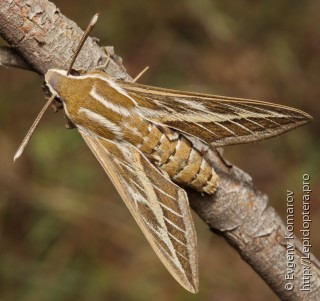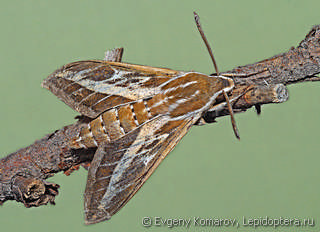Hyles livornica (Esper, 1780)

Taxonomy
class Insecta → subclass Pterygota → infraclass Neoptera → superorder Holometabola → order Lepidoptera → superfamily Bombycoidea → family Sphingidae → subfamily Macroglossinae → tribe Macroglossini → subtribe Choerocampina → genus Hyles → species Hyles livornica
Species name(s)
Hyles livornica (Esper, 1780) = Sphinx livornica Esper, 1780 = Phinx koechlini Fuessly, 1781 = Celerio lineata saharae Stauder, 1921 = Celerio lineata tatsienluica Oberthür, 1916 = obscurata (Niepelt, 19220) = perlimbata (Abbayes, 1932) = malgassica (Denso, 1944) = Hyles renneri Eitschberger, Danner & Surholt, 1998 = Hyles lineata livornica = Hyles (Danneria) renneri. [9, 10]
Striped Hawk-moth.
urn:lsid:insecta.pro:taxonomy:2829
Expansion
This species marks on the maps: 2.
Zoogeographical regions
Palaearctic, Neotropic, Ethiopic, Indo-Malayan, Australian.
Russia regions
#8. Evropeisky Tsentralny; #9. Evropeisky Tsentralno-Chernozyomny; #10. Sredne-Volzhsky; #11. Volgo-Donsky; #12. Nizhnevolzhsky; #13. Zapadno-Kavkazsky; #14. Vostochno-Kavkazsky; #16. Sredne-Uralsky; #17. Yuzhno-Uralsky; #20. Yuzhno-Zapadnosibirsky.
Forewing length
30—40 mm.
Primary colors
Red, Green, Brown/Gray/Black.
Flight time
| January | February | March | April | May | June | July | August | September | October | November | December |
Larva lifespan
| January | February | March | April | May | June | July | August | September | October | November | December |

Detailed information with references
Distribution
- Albania, Austria, Belgium, Bulgaria, Great Britain, Hungary, Germany, Greece, Denmark, Ireland, Spain, Italy, Corsica, Crete, Latvia, Luxembourg, Malta, Netherlands, Poland, Portugal, Romania, Sardinia, Sicily, Slovakia, the Soviet Union - The European part of Turkey - European part, Finland, France, Czech Republic, Switzerland, Sweden, Estonia, Yugoslavia. [1].
- Austria, Azores?Albania, Andorra, Balearic Islands, Belarus, Belgium, Bulgaria, Bosnia and Herzegovina, the British Isles, France, Germany, Gibraltar, Greece (mainland), Denmark (mainland), Ireland, Spain (mainland), Italy (mainland part), Canary Islands, Cyprus, Corsica, Crete, Latvia, Lithuania, Luxembourg, Madeira,Macedonia, Malta, Netherlands, Norway (mainland), the Channel Islands, the Savage Islands, Poland, Portugal (mainland), Romania, Russia, Sardinia, Northern Ireland, Northern Aegean Islands, Sicily, Slovakia, Slovenia, Turkey (European part) Ukraine, Faroe Islands, Finland, France (mainland)Croatia, Czech Republic, Switzerland, Sweden, Estonia, Yugoslavia. [10].
- Regions of the Russian Federation: the Volga-Don, East Caucasus, the European Central Black Earth, Central European, Western Caucasus, Lower Volga, Volzhsky Medium, Medium-Ural, South West Siberian, South Ural. [3].
- North Africa and Southern Europe butterflies fly north of the Alps, which are trying to breed, but they do not get it here - the winter temperature is too low. Generally, a line roisterer spread almost all over the world. Hyles livornica lives in Africa, Southern Europe and South Asia and Australia. In North America, we recall, it flies H. lineata. [5].
Imago Habitus and Differences from alike species
- Previously not considered a separate species, and race Hyles lineata livornica American speciesHyles lineata. The length of the front wing - 3 to 4 cm. Accordingly, the dimensions may vary from individual to individual quite strongly, although the strong differences between the sexes is not - females only slightly larger than males.The difference in size is largely explained by differences in feeding conditions in the caterpillar stage. The contrasting color of the front wings Leghorn hawk is such that this moth confused with others very difficult. [5].
General info about Imago
- Imago Hyles livornica active in the twilight hours, but during their characteristic flight of easy to spot during the day. [5].
Imago lifespan
- In May and June of butterflies flying in Europe north of the Alps can be found moths who were born in July-September. [5].
General info about Larva
- Color tracks - yellow-green, sometimes black, with white dots. [5].
Larva food plants / other food objects
- Vitis, Parthenocissus, Galium, Euphorbia, Linaria, Epilobium, Antirrhinum, Rumex, Scabiosa, Linum, Fuchsia, Asphodelus, Gossypium. [28].
- Ivan-tea, bedstraw, and others. [5].
Larva lifespan
- The larvae live from June to August. [5].
Authors
Initial species uploading to the site: Peter Khramov.
Photos:
Evgeny Komarov. Text data: Peter Khramov.
The species characteristics formalization: Peter Khramov.
References
- [1] O. Karsholt, J. Razowski (eds.), 1996. The Lepidoptera of Europe: a distributional checklist
- [3] Каталог чешуекрылых (Lepidoptera) России. Под ред. С. Ю. Синёва. СПб.; М.: Товарищество научных изданий КМК, 2008
- [5] Райххолф-Рим Х. Бабочки. М.: Астрель, 2002
- [9] Tree of Life (funet.fi), 2012
- [10] de Jong, Y.S.D.M. (ed.) (2011) Fauna Europaea version 2.4 (faunaeur.org)
- [28] Moths and Butterflies of Europe and North Africa (leps.it), 2012
Comments
Note: you should have a Insecta.pro account to upload new topics and comments. Please, create an account or log in to add comments
Hyles livornica photos
Other species Hyles





























